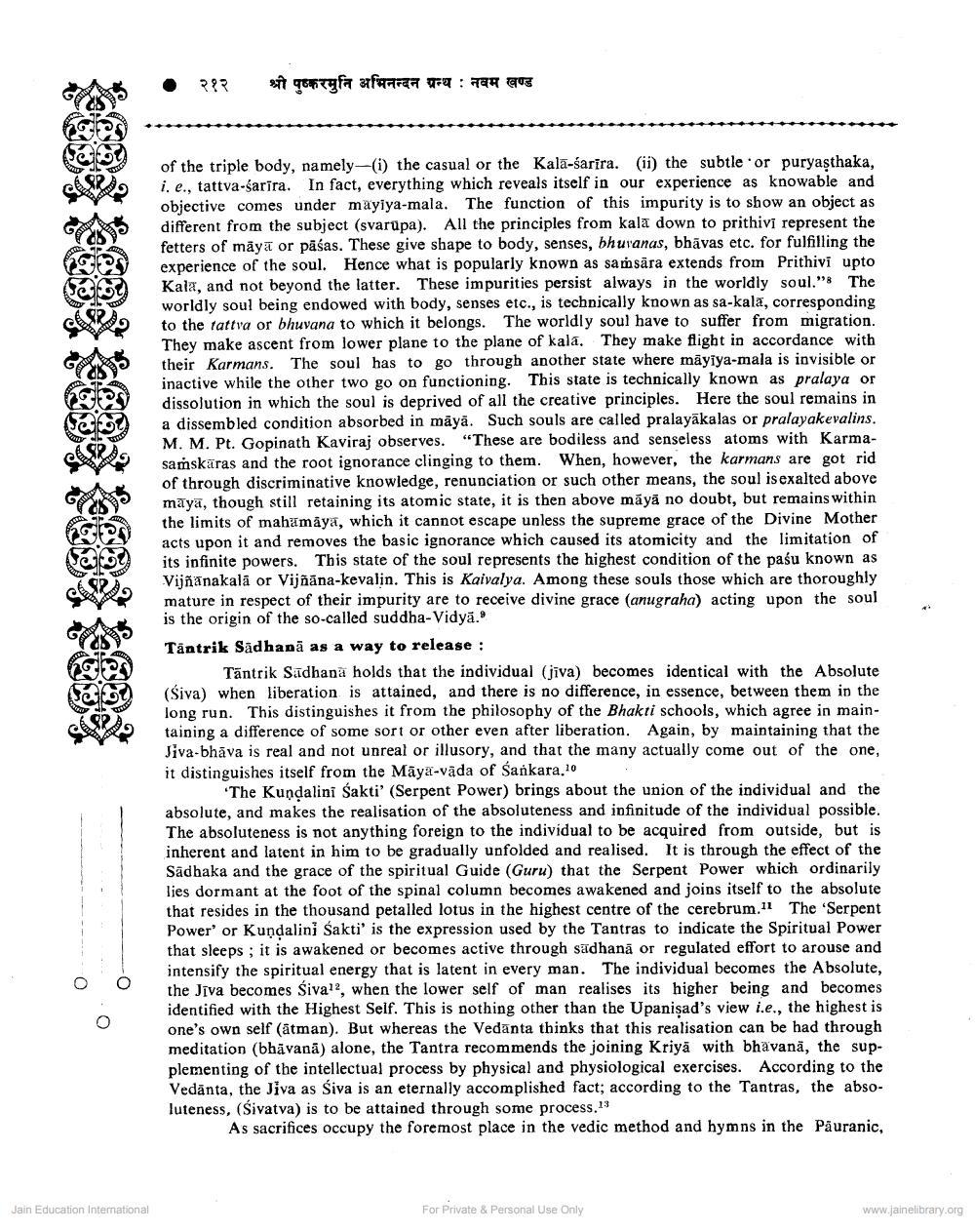Book Title: Philosophy of Tantrik Yoga Sadhna Author(s): Vaishishtha Narain Tripathi Publisher: Z_Pushkarmuni_Abhinandan_Granth_012012.pdf View full book textPage 3
________________ . २१२ श्री पुष्करमुनि अभिनन्दन ग्रन्थ : नवम खण्ड of the triple body, namely-(i) the casual or the Kala-sarira. (ii) the subtle or puryasthaka, i. e., tattva-Sarira. In fact, everything which reveals itself in our experience as knowable and objective comes under mayiya-mala. The function of this impurity is to show an object as different from the subject (svarupa). All the principles from kala down to prithivi represent the fetters of maya or pāśas. These give shape to body, senses, bhuvanas, bhāvas etc. for fulfilling the experience of the soul. Hence what is popularly known as samsära extends from Prithivi upto Kala, and not beyond the latter. These impurities persist always in the worldly soul." The worldly soul being endowed with body, senses etc., is technically known as sa-kala, corresponding to the tattva or bhuvana to which it belongs. The worldly soul have to suffer from migration. They make ascent from lower plane to the plane of kala. They make flight in accordance with their Karmans. The soul has to go through another state where māyiya-mala is invisible or inactive while the other two go on functioning. This state is technically known as pralaya or dissolution in which the soul is deprived of all the creative principles. Here the soul remains in a dissembled condition absorbed in māyā. Such souls are called pralayakalas or pralayakevalins. M. M. Pt. Gopinath Kaviraj observes. “These are bodiless and senseless atoms with Karmasaṁskaras and the root ignorance clinging to them. When, however, the karmans are got rid of through discriminative knowledge, renunciation or such other means, the soul is exalted above maya, though still retaining its atomic state, it is then above māyā no doubt, but remains within the limits of mahamāya, which it cannot escape unless the supreme grace of the Divine Mother acts upon it and removes the basic ignorance which caused its atomicity and the limitation of its infinite powers. This state of the soul represents the highest condition of the pašu known as Vijñanakalā or Vijñāna-kevalin. This is Kaivalya. Among these souls those which are thoroughly mature in respect of their impurity are to receive divine grace (anugraha) acting upon the soul is the origin of the so-called suddha-Vidya." os Tantrik Sadhanā as a way to release : Tantrik Sadhana holds that the individual (jiva) becomes identical with the Absolute (Śiva) when liberation is attained, and there is no difference, in essence, between them in the long run. This distinguishes it from the philosophy of the Bhakti schools, which agree in maintaining a difference of some sort or other even after liberation. Again, by maintaining that the Jiva-bhāva is real and not unreal or illusory, and that the many actually come out of the one, it distinguishes itself from the Maya-vada of Sankara.10 'The Kundalini Śakti' (Serpent Power) brings about the union of the individual and the absolute, and makes the realisation of the absoluteness and infinitude of the individual possible. The absoluteness is not anything foreign to the individual to be acquired from outside, but is inherent and latent in him to be gradually unfolded and realised. It is through the effect of the Sadhaka and the grace of the spiritual Guide (Guru) that the Serpent Power which ordinarily lies dormant at the foot of the spinal column becomes awakened and joins itself to the absolute that resides in the thousand petalled lotus in the highest centre of the cerebrum.11 The Serpent Power' or Kundalini Śakti' is the expression used by the Tantras to indicate the Spiritual Power that sleeps ; it is awakened or becomes active through sadhanā or regulated effort to arouse and intensify the spiritual energy that is latent in every man. The individual becomes the Absolute, the Jiva becomes Śiva 2, when the lower self of man realises its higher being and becomes identified with the Highest Self. This is nothing other than the Upanişad's view i.e., the highest is one's own self (atman). But whereas the Vedanta thinks that this realisation can be had through meditation (bhāvanā) alone, the Tantra recommends the joining Kriya with bhavanā, the supplementing of the intellectual process by physical and physiological exercises. According to the Vedānta, the Jiva as Śiva is an eternally accomplished fact; according to the Tantras, the absoluteness, (Sivatva) is to be attained through some process. 13 As sacrifices occupy the foremost place in the vedic method and hymns in the Pauranic. Jain Education International For Private & Personal Use Only www.jainelibrary.orgPage Navigation
1 2 3 4 5 6 7 8 9
